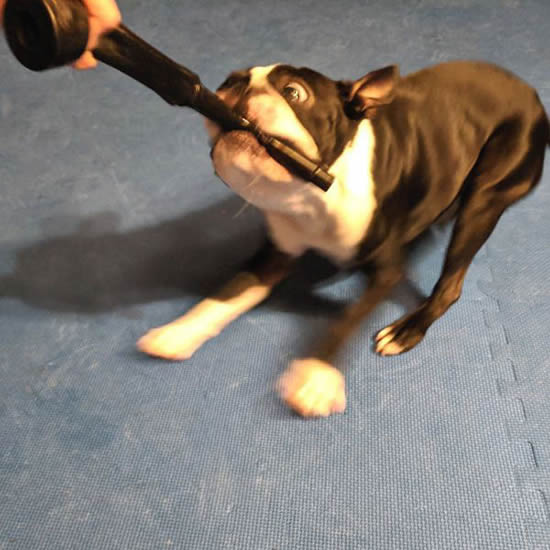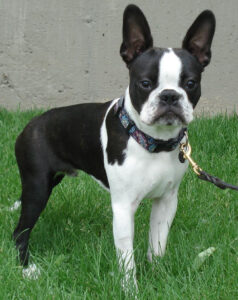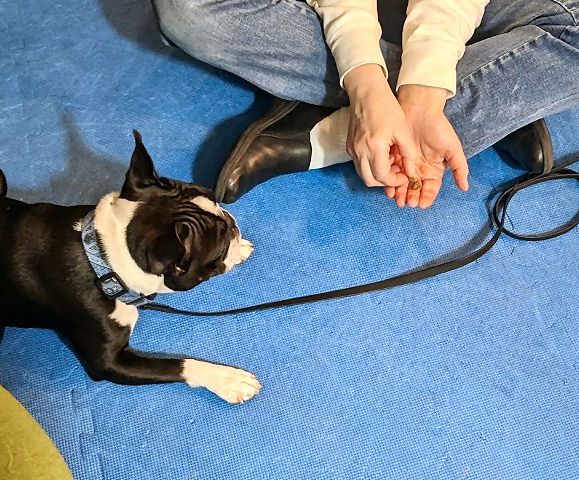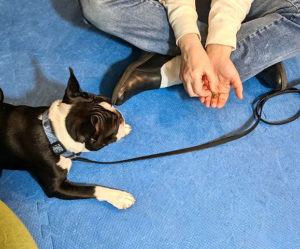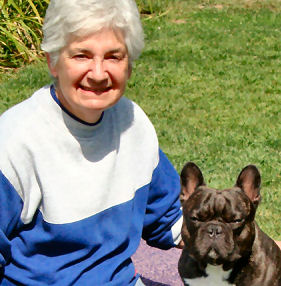All dogs are really “Push Me, Pull You” dogs. When your dog pulls on leash or tugs on a toy, they’re demonstrating what’s called the “opposition reflex.” While it may not be a real reflex, it is a trait that all dogs (and people!) have. Since it’s there, you may as well take advantage of it.
Simply put, it’s what happens when the dog resists being pushed or pulled. One way we test our dogs “Stay!” performance was to gently pull on the leash. The dogs resist the pressure to move. That uses their opposition reflex to further their understanding of what “Stay!” means.
You can also see it at work if you ever practice a “restrained recall.” That’s when someone holds your dog while you run away from the dog, calling to them. There’s nothing that gets most dogs revved up better. When dogs seem distracted and out of focus in obedience class, we use a restrained, or chase, recall to turn that around. You’ve also seen it at the start of any horse race, with the starting gate as the restraint. The dog sport Fast CAT uses it, too. Somebody holds the dog back at the start line while the lure speeds ahead.
Better, faster, stronger
The best way to teach your dog is to take advantage of their natural instincts. Whether the opposition reflex is a physical fact doesn’t matter. What does matter is that it works and you can use it in your training.
Say you want to teach your dog to hold something. Someone we know taught her dogs to hold a white board. She got a lot of mileage out of that behavior on social media. Think of the smiles you’d get if that’s how you made an announcement – just writing it on a white board and getting your dog to hold it.
Hold it!
So – how do you get your dog to hold onto something? We wrote about one way of teaching this, but here’s another: Make use of the opposition reflex. Teach the concept of hold when you play tug. It goes along with teaching the “Drop it!” command. If you’re putting pressure on the object your dog is holding, their instinct is to hold onto it with everything they’ve got. If you release all the pressure on the object, they’re more likely to drop it.
Start small, with something that has value for your dog, but not their favorite toy. If your dog doesn’t naturally love to play tug, start there. Most people think their dogs will be attracted to toys moving rapidly, flapped around in their faces. That’s not the way to do it. Instead, use your dog’s predator genetics and get them to stalk and pounce on your tug toy. Move it slowly, on the ground, back and forth. If your dog doesn’t respond right away, up the ante by gently touching their front paws as you sway the toy back and forth. Wiggle it, but not quickly.
Hope’s first agility dog was a French Bulldog named Dax. Dax didn’t tug. Had no interest in toys. But tugging is a great way to get your dog amped up and ready to play with you. Also, her agility instructor insisted that dogs must play tug with their people. Hope had to find the irresistible tuggy for Dax.
While she didn’t care about toys, she was highly food motivated. Dax’s push-me pull-you came roaring out when Hope used semi-limp celery for a tug object. Each rib may only have lasted a few minutes, but it got the job done.
Push Me Pull You Dogs
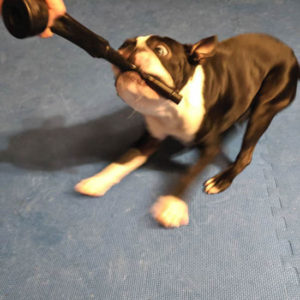
When your dog tugs, they naturally shift their weight back and resist your exertion. Keeping up a gentle pressure encourages your dog to hang on. Easing the pressure, without entirely letting go, turns into a “Hold it!” If your dog drops the object, start again. Try to figure out where your dog is letting go, and try to keep the pressure level just above that at first.
When your dog is hanging on to the toy, encourage them to move with you a little bit at a time. By incrementally decreasing your hold on the toy, while getting your dog to move, you’re building the dog’s hold and carry skills.
Once you and your dog are successfully holding and moving with the toy, it’s time to go back to the start using different objects; other toys, maybe a spoon, a tote bag with handles, and that white board. Whatever you’d like your dog to hold, introduce step by step. And we take advantage of the fact that all dogs are “push me pull you” dogs!
Don’t be quiet!
We’ve noticed that people seem reluctant to talk to their dogs in group classes. But providing feedback to your dog throughout your training game sessions is crucial. Dogs learn words by hearing them in context. Give your dog the words; “Hold it!” “Good Hold!” “That’s Hold it!” Use whatever word works for you. You get to decide what words mean to your dog.
Once your dog is fairly conversant with a new game or behavior doesn’t mean it’s time to stop talking. Keep talking to let them know you’re engaged in the game, too. If your dog drops the object, don’t repeat a command “Hold!” Instead, ask them “What were you doing?” “What’s the game?” And wait. This is the most difficult part for most people. But letting your dog think things through is essential for learning. When they come up with the right answer and pick up the toy, praise and reward.

